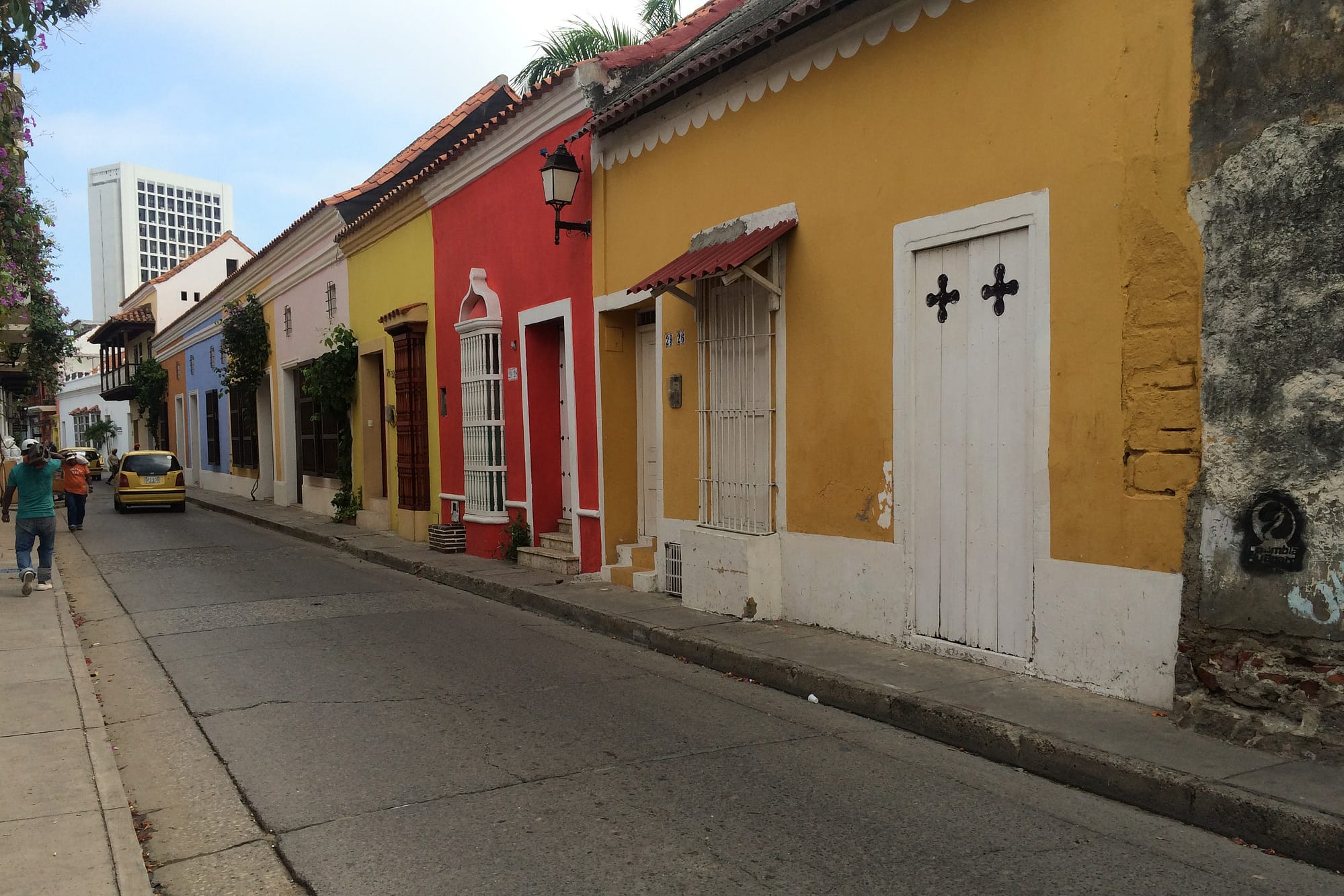I have learned that in Colombia it is possible to hire someone to take you anywhere you could possible want to go, usually at a fairly reasonable price, but it can sometimes be an adventure for those with little experience (me). My journey from Parque Tayrona to Cartagena was no exception, and I was glad to have the company of a friendly Argentinian couple that I met on the way out of the park. Apparently there are buses to Cartagena that stop near the park entrance, but they are infrequent and most stop in Barranquilla, a city halfway between Santa Marta and Cartagena. So we shared a van with two other people to the Santa Marta bus station, where buses to Cartagena are more frequent.
At the bus station we were immediately accosted by representatives of the different bus companies, all trying to convince us to go with them. What I learned from this trip is that they will say anything to get your business, whether it’s true or not. We told them we wanted to go to the city center of Cartagena without stopping in Barranquilla or changing vehicles, and one man told us that’s exactly what his bus would do, and he would only charge us 15,000 COP. In the end though, the bus only went to the Cartagena bus station, not the city center, and we did stop and change vehicles in Barranquillla, and they charged us 20,000 COP. But at least we got there in good time with no delays — the bus left right after we boarded, and the vehicle swap took no time at all. We finally made it to our hostels in the city center via taxi, which actually turned out to be a great way to see parts of the city that tourists normally wouldn’t visit.
Cartagena is a charming city — lively, friendly, beautiful — but the heat is a dealbreaker for me. It’s nice to visit for a few days, but I could never live here. I’ve taken to exploring in the early morning and hiding in air conditioned cafes from mid-morning until sundown to avoid the misery. Colombia in general doesn’t have much of a coffee shop culture, but in areas frequented by foreigners they are more common. I’m staying in the historic city center, which is mostly dedicated to tourism, so there are quite a few good coffee shops here. Café San Alberto is a tiny but comfortable place that is the commercial outlet of a coffee farm by the same name in Quindío, so they take coffee very seriously, and I can testify that they make a mean latte. Mila is a French-style cafe where everything — the coffee, the pastries, the food — is delicious, gorgeous, and pricey. My favorite by far is Ábaco, a bookstore and coffee shop that plays a lot of old school jazz music and has weekly lectures that draw a very intellectual crowd. On my last night in the city I was lucky enough to hear an interview with a prominent journalist, Claudia Palacios, about her new book, Perdonar Lo Imperdonable, a collection of interviews with victims of violence and its perpetrators in the Colombian conflict.
Thank goodness my hostel, El Viajero, has air conditioning in the bedrooms and is otherwise pretty awesome, with super helpful staff and great facilities (on the scale of hostels, not luxury hotels). I had a reservation for a bed in a shared dormitory Wednesday through Friday, but I walked in on Monday asking for a private single, and they did everything possible to try to make it happen. I ended up in a dorm the first night, but for the rest of my stay I’m in a huge private room that has a double bed, and they are only charging me for a single. The hostel is full of young, social travelers who make ample use of the two patios, the bar, and the daily activities that the hostel organizes, like dance lessons and game nights. It’s pretty noisy in the evening, but the bar and patios close at midnight, so I just resigned myself to staying up until then every night.
There is no shortage of tourist activities, especially since Cartagena is the largest and most important of the well-preserved colonial cities in Colombia, but to be honest, I didn’t visit many of them. I was more interested in just soaking in the vibe of the city and getting some reading and writing done. The beach here is kind of terrible, but it’s easy to take a day trip to beautiful, white-sand beaches. I had more than enough beach time in my 24 hours at Parque Tayrona, so I stayed in the city. I did check out the Museo de Oro y Arqueologia and the Museo Histórico de Cartagena / Casa de la Inquisición, two museums that are located next to each other. They are good places to visit for people who are in learning about the history of the indigenous tribes in this region and the colonial history of the city.
Cartagena looks and feels completely different from Medellín. Instead of patios that are open to the street, brightly colored walls rise up from the sidewalk two or three stories, with only a few shuttered windows or perhaps a small balcony facing the street. Houses are oriented towards interior courtyards, where walls, overhangs, and trees provide relief from the blazing sun. People here seem to be in less of a rush, and certainly the drivers are less aggressive. The streets are a messy mix of cars, motorcycles, bicycles, pedestrians, and in the city center, horse-drawn carriages ferrying tourists around. The accent is significantly more difficult for me to understand, as words tend to lose their consonants and blur together. The ethnic mix here is different as well, with very few people of obviously European decent and much more mixing with African and indigenous heritage.
The historic city center is positively photogenic, with rows upon rows of brightly colored houses graced with vines and flowers. The neighborhood just next to the old walled section of the city, Getsemani, is home to some fantastic street art, much of it hidden away on small, nearly abandoned blocks. I spent a few hours just wandering the streets and taking in the scenery. In the tourist areas the streets are very well-kept, but from what I saw in the taxi ride from the bus station, this cleanliness doesn’t extend to the rest of the city, where the streets and parks are full of litter. As in most large cities, the divide between wealthy and poor neighborhoods is painfully clear.
The shoreline is not much to look at here, but the view of the sunset from the old wall that surrounds the city center is something no visitor should miss. I was advised to enjoy it with Mamoncillo gelato from Gelateria Paradiso, and I am happy to verify that this is an excellent suggestion.


